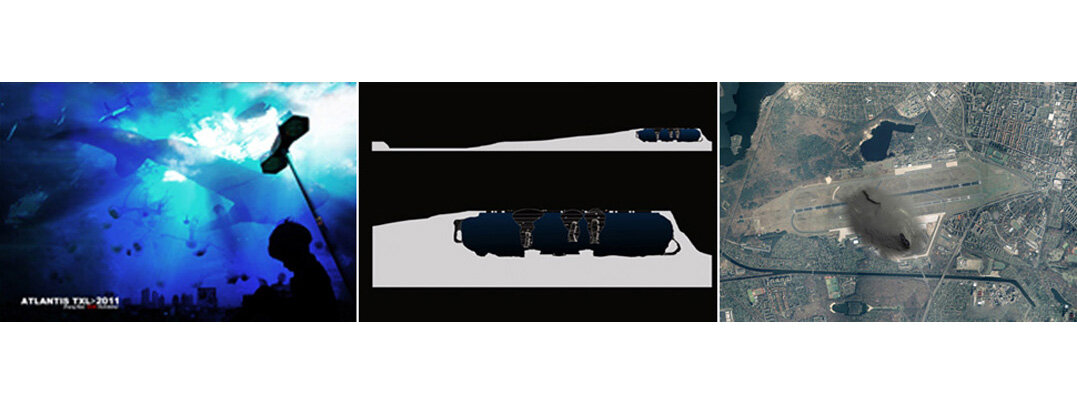teaching
TXL > 2011
Design Studio Masterclass in Architecture 2010
China Academy of Arts, Hangzhou
TUTORs
Annette Erlenwein, Claudius Pratsch
At the end of 2011, Berlin's Tegel Airport, built from 1969-1976 on some 460 hectares in the northwestern part of the city, will be closed.
Its six-sided building with an effective area of ca. 20,000 m² was considered an icon of the free zone "West Berlin".
Tegel airport was the first construction realized by the architectural office of Meinhard von Gerkan.
Berlin is one of Germany's most liberal and international cities.
Berlin is a city of nightclubs, informal subculture [squat scene since the 1980s] and creative economy [film, television, publishing houses, games, music, fashion, design].
The economic growth of the city, however, is stagnating or in decline.
The unemployment rate is high in comparison to other German cities [14%].
Berlin has a surplus of space, a surplus of abandoned industrial lots and former transportation facilities. This is linked to the effects of globalization on economic development, but is also a result of the particular development of the city since the fall of the Wall and Reunification in 1990.
There is no economic incentive to utilize the potential of these vast empty building structures and little demand from investors.
Such areas and their buildings are thus rented out on a temporary basis by the city government at low prices, resulting in informal, self-organized architectures that are quite characteristic of Berlin.
Due to the difficulty of long-term urban development planning (also because of the international economic crisis), strategies for the secondary use of Tegel Airport are sought, which are flexible, adaptable and process-oriented.
The purpose of the study is to explore nonpermanent, instable aspects of architecture that can adapt to morphologically variable conditions, and architectures that are dynamic and follow a temporal component – whose attraction and aesthetic lies in the process-oriented, in a state of constant incompletion.
The pending availability of the Tegel Airport grounds shall serve as the project's point of departure and field of experimentation.
The lack of investment and development incentive should be treated as a possibility to use the grounds as a laboratory for this kind of architectonic experiment.
Ende 2011 soll das Flughafengelände und die baulichen Anlagen des 1969-76 gebauten Flughafens Tegel im Nordwesten Berlins aufgegeben werden. [ca. 460ha]
Die sechseckigen Gebäude mit ca. 20.000 m² Nutzfläche galten als Ikone des damals eingeschlossenen freien Westberlin. Es ist das erste realisierte Bauwerk des Architekturbüros Meinhard von Gerkan.
Berlin ist eine der liberalsten und internationalsten Städte Deutschlands.
Berlin ist die Stadt der Clubs, der informellen Subkultur [Hausbesetzer-Szene seit den 80er Jahren] und der Kreativwirtschaft [Film, Fernsehen, Verlage, Spiele, Musik, Mode, Design].
Das wirtschaftliche Wachstum der Stadt jedoch stagniert bzw. ist rückläufig.
Die Arbeitslosenzahl ist verglichen mit anderen deutschen Städten hoch [14%].
Berlin hat ein Überangebot an Raum, ein Überangebot an freien ehemaligen Industrieflächen und aufgegebenen verkehrlichen Anlagen. Das hat mit der wirtschaftlichen Entwicklung durch die Globalisierung zu tun, aber auch ganz speziell mit der Entwicklung der Stadt seit dem Fall der Mauer und der Wiedervereinigung in 1990.
Der wirtschaftliche Druck, diese großen freien baulichen Strukturen und Areale zu erschließen ist nicht gegeben. Die Nachfrage von Investoren ist sehr gering.
Daher werden derartige Areale mit ihren Gebäuden von der Stadt günstig temporär verpachtet, sodass informelle selbst- organisierte Architekturen für Berlin sehr typisch sind.
Da die weitere Entwicklung Berlins, auch wegen den Auswirkungen der internationalen Wirtschaftskrise, schwer langfristig planbar ist, sind flexible, anpassungsfähige, prozesshafte Strategie die Nachnutzung des Flughafengeländes Tegel gefragt.
Die Studienaufgabe beschäftigt sich mit nicht-permanenten, instabilen Aspekten in der Architektur, mit Architektur die sich morphologisch unterschiedlichen Bedingungen anpassen kann und Architekturen, die dynamisch sind, und einer zeitlichen Komponente folgen, deren Attraktion und Ästhetik im Prozesshaften, immer Unfertigen liegt.
Das freiwerdende Flughafenareal in Tegel soll dabei als Ausgangspunkt und Experimentierfeld dienen.
Der mangelnde Investitions- und Entwicklungsdruck soll als Möglichkeit gesehen werden, Tegel als Labor für diese Art von architektonischem Experiment zu nutzen.
Zhang Nan TXL Atlantis
Lu Si TXL - Botanic Research Center
Deng Zhaozhong TXL Mnemonic Space
Li Jiao TXL Museum for Landart





